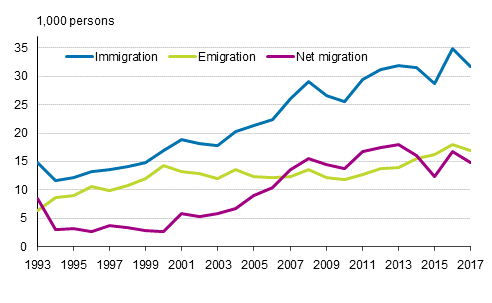Published: 30 October 2018
Net immigration lower than in the previous year in 2017
Corrected on 24 October 2019. The corrected numbers are indicated in red.
According to Statistics Finland, 31,797 persons moved to Finland in 2017, which was nine per cent fewer than one year earlier. The number of immigrants was 3,108 persons lower than in 2016. Emigration also decreased from the previous year. A total of 16,973 persons moved abroad from Finland, six per cent more than in the year before. The migration gain for Finland fell to 14,824 persons from the previous year's 16,823.
Migration between Finland and other countries 1993–2017

Of immigrants, 23,735 or 75 per cent were foreign citizens in 2017. Sixty per cent of emigrants, 10,167, were Finnish citizens. Finland's migration gain from foreign citizens amounted to 16,929 persons, but Finnish citizens generated a migration loss of 2,105 persons.
Immigration gain from immigrants from outside the EU
Finland's migration gain consisted almost completely of immigrants from outside the EU in 2017. However, immigration from countries outside the EU decreased from the year before and emigration to countries outside the EU was also lower. Net immigration from countries outside the EU decreased to 14,249 from the previous year's 15,716.
Immigration gain was largest from Iraq, 2,369 immigrants, second largest from Syria, 1,422 immigrants, and third largest from Russia, 1,420 immigrants.
Immigration from EU countries to Finland went down by 721 persons from the previous year to 12,192 in 2017. Emigration to EU countries has in turn now become more steady. Last year, 11,617 persons emigrated from Finland to other EU countries, which was 189 persons fewer than one year previously. As a result of the development described above, Finland’s migration gain from EU countries was nearly half of what it was the year before, 575 persons.
More intermunicipal migrations, as migrations within municipalities, too
In 2017, the number of intermunicipal migrations totalled 287,839, which was 5,582 more than in 2016. The number of migrations between regions was 136,684, with a growth of 3,454, having been just 686 in the year before. Migrations between regions numbered 151,155, which was 2,128 more than one year earlier. In 2017, the number of intramunicipal migrations on 592,051 , which was 1,221 higher than in 2016.
When looking at migration inside the country, the region of Uusimaa had the largest and the region of Pirkanmaa the second largest migration gain. In Uusimaa, the gain amounted to 7,804 and in Pirkanmaa to 2,109 persons. The migration gain relative to the population in Mainland Finland was largest in Uusimaa, where the migration gain was nearly five per mil. The relative migration gain in Pirkanmaa was slightly lower than in Uusimaa.
The region having suffered the largest population loss in migration inside the country was Ostrobothnia, 1,402 persons. Kymenlaakso had the largest relative migration loss of nearly eight per mil. The relative migration loss was the second largest in Ostrobothnia. In intramunicipal migration 15 regions suffered from migration loss.
Migration gain for regions from immigration
All regions received migration gain from international migration. Taking that into account, the number of regions with migration loss falls somewhat. The sum of net immigration and net emigration was negative in twelve regions. In Mainland Finland, net regional immigration was highest in Ostrobothnia and lowest in South Ostrobothnia in relative terms.
Internal migration and in- and out-migration 2005–2017
| Year | Intermunicipal | Intramunicipal | Immigration | Emigration | Net migration |
| 2005 | 267 939 | 624 030 | 21 355 | 12 369 | 8 986 |
| 2006 | 265 469 | 600 097 | 22 451 | 12 107 | 10 344 |
| 2007 | 272 285 | 595 985 | 26 029 | 12 443 | 13 586 |
| 2008 | 262 454 | 567 619 | 29 114 | 13 657 | 15 457 |
| 2009 | 257 595 | 577 668 | 26 699 | 12 151 | 14 548 |
| 2010 | 264 362 | 575 323 | 25 636 | 11 905 | 13 731 |
| 2011 | 274 896 | 600 781 | 29 481 | 12 660 | 16 821 |
| 2012 | 274 650 | 595 163 | 31 278 | 13 845 | 17 433 |
| 2013 | 265 844 | 577 960 | 31 941 | 13 893 | 18 048 |
| 2014 | 267 799 | 571 775 | 31 507 | 15 486 | 16 021 |
| 2015 | 280 271 | 613 474 | 28 746 | 16 305 | 12 441 |
| 2016 | 282 257 | 590 830 | 34 905 | 18 082 | 16 823 |
| 2017 | 287 839 | 592 051 | 31 797 | 16 973 | 14 824 |
Source: Migration 2017. Statistics Finland
Inquiries: Joni Rantakari 029 551 3249, Matti Saari 029 551 3401, Timo Nikander 029 551 3250, info@stat.fi
Director in charge: Jari Tarkoma
Publication in pdf-format (282.8 kB)
- Tables
-
Tables in databases
Pick the data you need into tables, view the data as graphs, or download the data for your use.
Appendix tables
- Figures
- Quality descriptions
-
- Quality description, migration 2017 (30.10.2018)
Updated 30.10.2018
Official Statistics of Finland (OSF):
Migration [e-publication].
ISSN=1797-6782. 2017. Helsinki: Statistics Finland [referred: 18.12.2025].
Access method: http://stat.fi/til/muutl/2017/muutl_2017_2018-10-30_tie_001_en.html

